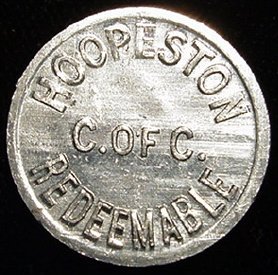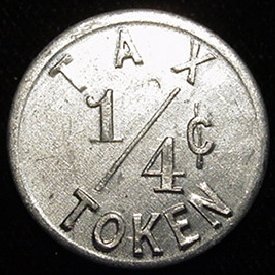Here’s another in our series of the many different Illinois provisional sales tax tokens.
This is the provisional token from Hoopeston Chamber of Commerce. It is listed in the M&D book as number “L42”, held the value of a quarter of a cent at the time, had a rarity rating of R3 at the time of the M&D book and is made of aluminum.
I’ve said twice now that the token in question “had a rarity rating of [such-and-such] at the time of the M&D book” because the book is now 20 years old and it’s always possible that the rarity might have changed. Currently, Monte Dean is working on a new book (the 4th volume in his series) which is due out next Spring, and I’m sure that we can expect many of these rarity ratings to be updated.









Hey Loran, and All - The following is from memory only, as all my references are on Missouri right now and I couldn’t begin to touch any pile in fear of avalanches occuring:
I’m about 95% sure Merlin did an absolutely extensive research article on how the different fonts used on specific merchant and provisional tokens of Illinois could be followed back to known minters. I’m about 80% sure that it was an article that I included in the Illinois chapter of Sales Tax Tokens and Scrip; Histories. So if you have the time to search, that’s the place to look. It would have been an ATTSN article, and I’d guess it’s in the 1990’s.
He not only used the font and number types as guides, but included planchete sizes and weights, too.
From what I remember, since there were a few tokens that had bills of lading still in existence, or for which the minter had been recorded (probably by Magee), Merlin was able to make a case for a goodly number of the tokens having been made by only a few known mints (less than 6), with a number of other tokens that could not be nailed down.
As was the case with all of Merlin’s articles, it was extremely detailed, and I’m certain if you look that information up it will give you an excellent education on the specifics. I apologize for not being able to find the issue number for you right now, but I really do have so many piles of research material piled around the table I’m working at that I honestly do fear messing it up. It’s one of those things that if I took a picture of the tables I’m using it would look like a library was bombed, but I really do know where everything is! Monte
The M&D actually did an astoundingly accurate job of specifying rarity rating numbers for the vast majority of the tokens and items listed in their book.
The single greatest difference between the majority of changes that will occur to the rarity ratings is simply due to eBay and our ability to track the actual sales of tokens over a great period of time. Something Tim and Merlin did not have the advantage of using. I’ve been recording sales of tokens, scrip, and related memorabilia for better than 15 years with nearly 30,000 reported sold-for prices recorded. That is simply something that has only been possible since the M&D was last printed.
Additionally, Merlin, who did most of the rarity assignments, strictly adhered to the policy of “known” tokens. Meaning that if HE only knew about one of them, he reported that token as R-10, Unique. This next book, the STTS; ID & PG, will have used the many recorded prices of the past to be able to better extrapolate a likely rarity beyond what “I” know and only what I know.
In other words, just because I only “know” of 3 rarer items in 3 collections and have recorded only 2 sales to unknown buyers for that same piece, does not mean that there are only 5 on them on earth. To calculate a better rarity rating, there must be other factors taken into consideration.
For example, for the piece I list above, I know there are AT LEAST 5 known. Using the same strict standard that Merlin used, I would put the rating at R-8 (5-10 Known). And that rating may well be what is used for the last book - OR NOT.
How I’ve determined the rarity rating most certainly does use the number sold during a specific time period and known examples as PART of the equation. But common sense must also have an influence. In the M&D, the worst examples of rarity ratings that will most certainly be moving down, in some cases several points, are in the areas of NON-state issued METAL tokens. During the period that the M&D was written, there were relatively few collectors that collected anything OTHER than state issues. There were some that also collected scrip, but fewer. There were some that collected Ohio stamps, but far fewer.
Since there were many fewer collectors who included what was then considered “odd” pieces, such as the Texas anti-sales tax tokens that were given a rarity rating of R9 or R10, the New York anti-sales tax token given a rating of R10, or the Doersam’s Pre-Paid from Ohio that was assigned an R10, too, Merlin had fewer collectors to report their existence.
I intentionally included those tokens in the above paragraph because they likewise had one other thing in common - they were all made of METAL. Depending on the time and the minter, tokens could be made for just about any purpose for relatively small costs, but there was usually an absolute minimum of 500 (after 1946), or 1000 (pre- 1941). So it is EXTREMELY unlikely a token minted prior to about 1967-69, would have had fewer than 500 initially minted. In some cases, as with the Texas, it was known and reported prior to the M&D assigning rarity ratings of R-9 that tens of thousands of them were initially produced.
A metal token, though easy to mislay, throw out, or simply lose, still exists somewhere unless it is melted or left to corrode completely. So the chances that a metal token that had at least 500 examples made (depending on the time period) only having one left on planet earth is not terribly likely. Thus, the biggest drop in rarity ratings, as has been proven by the last decade and a half of eBay sales, will be for those non-state issued metal tokens of one kind or another which have been proven to be much less than R10, or even R9.
In addition to common sense in evaluating the probable remaining examples of a particular token, the type of token or scrip and how and when they were reported must also have an influence on those ratings. In other words, if all 3 known examples of a particular cardboard scrip issue were discovered together some 30 years ago, and no other examples have been seen since, the likelihood that more will appear is fairly marginal. That is not saying impossible - but highly unlikely.
So for much less durable materials, such as paper, cardboard, or wood, especially if the known examples have surfaced together from a single find, the likelihood of more becoming known becomes ever smaller as the years pass. In fact, there are numerous examples when the only known examples of some scrip (and even tokens) all came from a single time from a single hoard with no other examples ever reported since then. Even some of the recent finds we’ve had reported on such oddities as pin back buttons, merchant signs, and anti-sales tax material all originated from a single seller during a brief time, and since then no further examples have come onto the market.
So hoard distribution, which is a subject discussed in detail, likewise has an influence on the possible or probable rarity of a given piece. Although I most certainly do appreciate and understand why the M&D used the system of only reporting what they actually personally knew as far as rarity is concerned, I do believe that the past records I’ve accumulated make it more accurate to extrapolate based on something other than just my own personal knowledge.
Will I get some wrong? Probably the day after this book hits collectors hands we will hear all about them! Monte
Monte,
Maybe you can answer this… I noticed that the fonts for both of the Illinois provisional tokens that I’ve just posted look the same. The word “redeemable” seems to have the same qualities in the letters and the number “1” on both tokens is very unique and identifiable. Did the various counties just give the company a rough drawing of how they wanted their tokens to look and they used whichever font was available?